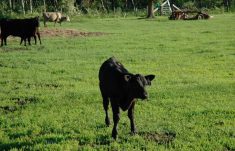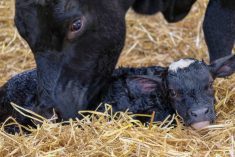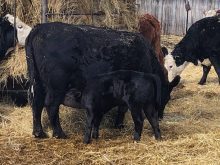Most calves are born head first, front feet extended, but a few are positioned backward and may not survive unless you are there to help with delivery.
The backward calf usually suffocates because his head is still inside the cow when his umbilical cord breaks or pinches off as his midsection comes through the cow’s pelvis. He will die unless you can speed the birth by pulling him out when he reaches that point.
A calf coming backward is a slow birth (unless the calf is very small) because he is not streamlined. Mother Nature has things planned for frontward delivery, stretching the cow’s cervix and vulva gradually as front legs and head come through before the larger shoulders and even-larger hips. But with hind legs first, the big hindquarters must come through early. This takes a lot of stretching. When pulling a backward calf, apply lots of lubricant — as far into the birth canal alongside the calf as you can.
Read Also

Harvest wraps up and fall work begins
At the Eppich famly ranch in western Saskatchewan, the fall harvest was successful with few breakdowns, cows and calves have been sorted and a new tractor has arrived
It may take the cow longer in early labour to get the calf’s hind legs aimed in the right direction. However, when his feet start to emerge through the vulva you can tell they are hind feet. Heels and dewclaws will be up with bottoms of the feet showing, rather than toes pointing down.
Before you assume the calf is backward, reach into the birth canal to feel the whole leg. If it’s a hind leg you will feel the hocks. If it’s a front foot you find knees (and head, unless it is turned back).
Check! Don’t just assume
Sometimes a frontward calf will be upside down or sideways, and when the feet first appear they are pointed upward. Always be sure which part of the calf is presented before you put chains on and start to pull. If they are front feet, reach in farther to make sure the head is there and not turned back, and rotate the calf into position before you assist. Don’t just assume he’s backward and start pulling.
You need to check inside the cow if she’s taking too long before the calf’s feet appear. Then you can tell if the calf is started into the birth canal, and whether it’s front feet or hind feet. If you think they are hind feet, one way to make sure is to reach along the top of the legs until you find the tail.
Restrain the cow where there’s plenty of room to use a calf puller and maneuver it properly. You don’t want her in the corner of a barn stall, too close to the wall. If she’s in a squeeze chute, the head gate should be one that will allow her to lie down without choking her, with sides that can swing away. Otherwise, be prepared to put a halter on her and let her out of the chute to tie her in an open area with room to maneuver a calf puller if she lies down.
[RELATED] Canadian Cattlemen: Contracted and lax tendons in newborn calves
Even if the cow is standing when you start to pull the calf, by the time you apply a lot of pressure (when the calf’s hindquarters are coming out) she will usually go down. This can harm her and/or calf if she goes down at a bad angle for the puller, so it’s best to put the cow on the ground before you begin. There are simple techniques with a rope to gently lay her on the ground.
A backward calf is one instance where you need a calf puller unless the calf is very small or you have several strong people to assist. Only a few backward calves are small enough to be pulled by hand. A rare few survive an unassisted birth if the cow calves fast and jumps up as the calf comes out so the membranes and fluids come away from his face and he can start breathing. Most calves don’t survive a backward birth unless you get them out quickly.

After the cow is restrained, do a more thorough check inside. Sometimes the umbilical cord is caught over a hind leg. This occurs if a hind leg passes under the cord as the legs are straightening to enter the birth canal. If this happens, the cord will stretch and break before the calf is halfway out. If the cord is caught over one of the legs, push the calf back into the uterus if you can — far enough to reposition that leg (flexing the hock tightly) to get it untangled from the cord. Make sure the calf’s tail is not straight up over his back, or his tail-head will jam into the cow’s pelvis and impede the birth.
Attach chains to the legs above the fetlock joints (double half hitch with one loop above and one below the fetlock joint, to reduce the risk for damaging the joint or breaking a bone), insert lubricant, and start pulling.
Start slow
Go slowly at first, giving the cervix time to fully dilate as buttocks and hips start through. Traction should be applied on one hind leg until its stifle has been drawn up over the brim of the cow’s pelvis. Pulling them one at a time enables the hindquarters to come through more easily, since they are wide and the pelvic opening will be tight on his stifles.
If hindquarters are still “stuck,” cross one leg over the other and pull hardest on the lower one. This will help rotate the calf a little to one side and ease the stifles through. Another way to rotate the calf is to bend the hind legs and use them as levers in a circular motion to twist the hindquarters. If it is rotated 45 to 90 degrees (nearly lying on his side), this takes advantage of the widest diametre (up-and-down) of the cow’s pelvis.
Check again to make sure the tail is not aimed up over the calf’s back or it may damage the birth canal as you pull, and break the tail-head. Put your hand over the calf’s rump and make sure the tail is down between its hind legs as he enters the cow’s pelvis.
The calf’s umbilical cord won’t pinch off until its hindquarters go through the pelvis, so pull slowly until hind legs are out past the hocks. Go gently until the hips are free and ribcage safely through the cow’s pelvis. Once the hips are clear of the vulva, hurry him on out. If you rush at first, you may injure the cow and kill the calf. A calf’s rib cage can be crushed if you pull too forcefully too soon.
Direction of pull should be straight out from the back of the cow, applied with a calf puller or three strong people. When using a puller with a winch/cable, stop briefly and reposition the chains above the hocks, especially if it’s a long-legged calf. This gives you more room (more length of cable) to winch. There’s nothing more frustrating than getting a big calf partway out and running out of cable with his head and shoulders still inside the cow. At that point he will be suffocating because the umbilical cord has been pinched or broken.
After you have the chains above the hocks and your cable repositioned, rotate the calf back into proper position (if you had to rotate his hindquarters to get his hips through the cow’s pelvis) and winch him on out. Go slowly and carefully until the calf’s tail-head and anus emerge, to make sure the back of his rib cage has started through the pelvis. You don’t want it to catch on the cow’s pelvis and be crushed by jerking it through. Once his hindquarters are emerging from the vulva, which means his rib cage has entered the pelvis, hurry him on out.
At this point some people pull downward rather than straight back to follow the natural arc of the birth canal, which makes it a bit easier. If you are using a calf puller, however, make sure the calf’s hips are nearly out before you pull downward. Sometimes a calf’s femur (between hock and stifle) will be broken, or femoral nerves damaged, from all the pressure on those leg bones when pulling at a bad angle — before the upper leg is free of the cow’s pelvis. It’s like breaking a stick over your knee.















